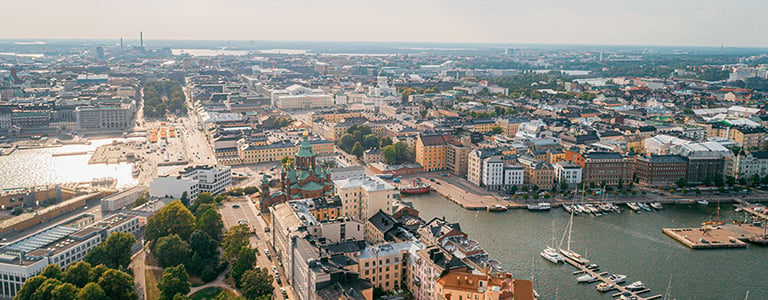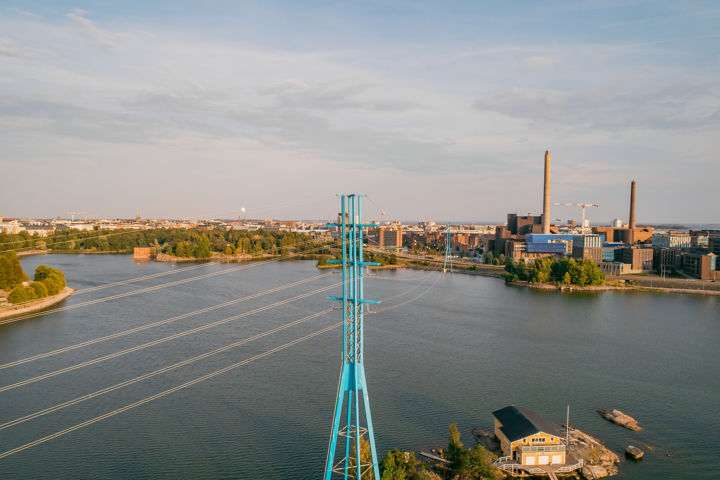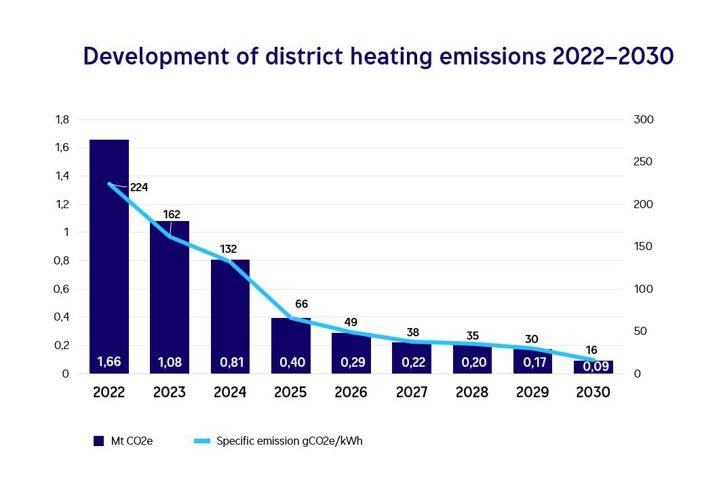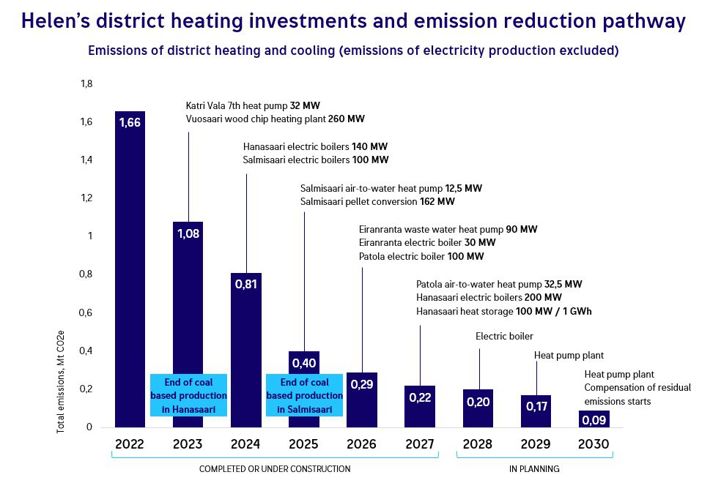
Carbon neutrality programme
Helen's goal is to be carbon neutral by 2030. In the carbon neutrality programme, we explain how we reduce carbon dioxide emissions and dependence on imported fossil energy as well as increase Finland's energy self-sufficiency.
Sustainable energy system
Helsinki's energy platform combines clean electricity, a reliable electricity network and flexible district heating with low-emission customer solutions. The flexibility of Helen's district heating system and the reliable electricity network enable energy production from multiple sources. The district heating network offers our customers a competitive, safe and reliable heating option. The green transition will multiply the need for electricity, and our customers can trust us to always deliver clean energy. We are accelerating the transition to carbon neutrality with various digital services, IoT solutions, energy data and digital user experience.
Reducing emissions
Helen has taken decisive action to reduce emissions. In 2023, the results became tangible when the Hanasaari power plant, which had served the residents of Helsinki for nearly 50 years, was decommissioned. With the decommissioning of the plant, our coal consumption was halved and our energy production took a major leap in a cleaner direction. Our greenhouse gas emissions* fell by 40 per cent and those of Helsinki as a whole by 20 per cent. The next significant turning point will be in 2025, when we abandon the use of coal altogether and decommission the Salmisaari power plant. Helen is the first Finnish energy company to receive official approval from the Science Based Targets initiative (SBTi) for its emission reduction targets.
Our emissions reduction* schedule
2024 at least 60% of the emissions in 1990
We will move towards decentralised heat production and a sustainable energy system. We plan to replace production with waste heat, sustainable bioenergy, energy storage, as well as nuclear, wind and solar power.
2025 at least 80% reduction compared to 1990 levels
Our heat production will mainly consist of heat pumps utilising waste and environmental heat, electric boilers, energy storage and sustainable bioenergy. We will produce electricity mainly with wind, nuclear, hydro and solar power.
2030 at least 95% of the emissions in 1990
We will further increase wind and solar power and the amount of non-combustion heat production especially with heat pump solutions. We will offset any remaining emissions.
*Scope 1 emissions include Helen's direct stack emissions, emissions caused by the company's vehicles and gas leakage emissions. Scope 2 emissions, on the other hand, include the emissions of the energy we consume. For Scope 3 emissions (3d), the target encompasses greenhouse gas emissions from the associated companies’ energy production as well as emissions related to the production of purchased and resold electricity and heat. The target limits include biogenic emissions and removals. Biogenic emissions have been treated as zero emissions in the target because sustainable biomass has a zero-emissions rating in the EU Emissions Trading System.
Clean electricity
The green transition is very much a revolution in electrification, resulting in a multiplied need for electricity. We need new, clean electricity production in order to meet the needs of an increasingly electricity-based society. In the future, Helen's electricity production will consist mainly of wind, solar, hydro and nuclear power. At the beginning of the 2020s, we made investment decisions for several large wind and solar farms, which will be completed in 2024 and 2025. In addition, the completion of Olkiluoto 3 in 2023 significantly increased the share of nuclear power in Helen's electricity production.

Helen is renewing its electricity production portfolio by abandoning coal-based fossil production capacity and increasing low-emission wind, solar and nuclear power capacity. In 2025, about 90 per cent of our total production will be emission-free.
In the same year, our annual wind power production will exceed the amount of electricity previously produced using coal. Natural gas capacity that simultaneously produces electricity and heat is needed when emission-free production is not enough to cover the demand for electricity, such as during unusually cold periods and windless periods of sub-zero temperatures. In these situations, this production can play a significant role in supporting the entire Finnish electricity system and stabilising the market price of electricity. The attached figure presents the structure of Helen's electricity production capacity in 2022 and 2026. The overall capacity of 2026 is under construction.
Electricity network
The supply reliability of electricity gains more and more importance as society becomes increasingly reliant on electricity. We enable the emission reductions of the City of Helsinki by connecting the low-emission production of the customers of Helen Electricity Network to the power grid in a way that does not create a bottleneck for the green transition.
Helen Electricity Network's investments are related to the development of the city and the promotion of the green transition. One of the biggest network changes in the coming years is related to the Western Boulevard City, concerning which Helen Electricity Network and the City of Helsinki signed an implementation agreement in 2024. With regard to Helen Electricity Network, the package includes the relocation of the Pitäjänmäki substation as well as the partial underground cabling of high-voltage 110 kilovolt overhead lines related to the substation, in order to enable the development of the Western Boulevard City.

Until recent years, Helsinki has been self-sufficient from the point of view of electricity transmission, thanks to fossil-based electricity production. This is about to change, with Helsinki becoming an importer of electricity. One significant factor in accelerating the development of the city and the green transition is the plan of the City of Helsinki, the transmission system operator Fingrid and Helen Electricity Network to extend the main grid to Viikki. The connection will be completed by 2026.
In addition, a new 400 kilovolt cable connection closer to the city centre will be needed in the future, as the main grid's capacity limits the implementation of Helen's planned carbon neutrality investments. Moreover, the 110 kilovolt cable connections between substations must be strengthened to ensure the supply of electricity to new heat pump plants and electric boilers also in the event of a fault.
Electricity storage and flexibility
The purpose of electricity storage and flexible services is to support the green transition, balance electricity price fluctuations and ensure the supply reliability of the electricity system. Helen has built an optimisation capability that utilises artificial intelligence for the flexibility market and invested heavily in electricity storage. In 2023, we launched a new service focusing on the operation of electricity storages, which optimises the offering of electricity stored in batteries in the electricity and reserve markets.
We have made investment decisions for several electricity storages, both in connection with wind and solar farms and in other locations. At the beginning of 2024, we invested in a 40 megawatt electricity storage in Nurmijärvi. In our strategy updated in 2023, flexibility has been elevated to one of our three focus areas alongside the green transition and profitability. Our goal is to continue investing in electricity storage and flexibility in the future as well.
Phasing out fossil fuels in district heating

The sustainable heat production of Helsinki is built on multiple sources that are based on a flexible district heating network. The water flowing in the district heating network can be heated in countless different ways.
We are moving to more electric and decentralised heat production that focuses on the utilisation of waste and environmental heat, electric boilers and sustainable bioenergy. In addition, we are developing heat trade with customers and other energy companies. Although Helen also has capacity based on fossil natural gas and oil, we estimate that its use will remain very marginal and we will achieve our 95 per cent emissions reduction target by 2030. This capacity also plays a key role in maintaining security of supply, as well as in managing the price stability of heating.
Investments in carbon neutral energy production improve the competitiveness of district heating in relation to building-specific solutions, which enables a diverse product offering to customers. Helen's goal is for the customer to be able to participate in the management of the energy system through their own actions and to benefit from it. Helen's product and service range for heating and cooling will be developed in such a way that the customer will be able to determine the target level for energy affordability and sourcing through their choices.

Development of district heating emissions
In 2023, the specific emissions of sold district heating decreased by almost 30 per cent, compared to 2022. According to the roadmap, the emission reduction of district heating will be about 70 per cent in 2025 and about 95 per cent in 2030. The specific emissions of sold district heating are estimated to be 16 grammes of carbon dioxide equivalent per kilowatt hour sold in 2030. Carbon neutrality is achieved by offsetting these remaining emissions.
The emission estimates in the table reflect those in a normal year. Annual emissions may vary due to temperature, market prices of commodities or exceptional situations. Emission-causing fossil energy production may need to be increased, for example, in the event of faults in fossil-free capacity, during unusually cold periods or when there are constraints in the electricity system, either due to electricity transmission or due to low electricity production relative to consumption.

Flexible heating
The timely utilisation of different forms of heat production supports the increasingly electricity-based society by providing flexibility to the electricity system. When the demand for heating is at its highest and there is scarcity of electricity, bioenergy and heat storages can be utilised.
When inexpensive electricity is efficiently available, district heating can be produced using electricity-based forms of production while recharging the storages. We also develop flexible consumption solutions together with our customers to avoid excess heating and enable demand response.

Production capacity shifting away from fossil sources
The majority of Helen's coal capacity was eliminated in the spring of 2023 when the Hanasaari combined heat and power plant and the Salmisaari coal-fired heating plant were decommissioned. The last coal-fired CHP plant in Salmisaari will be decommissioned on 1 April 2025.
The remaining low fossil production capacity ensures the security of supply of the heating system as well as the price stability of district heating.
The graph presents the development of Helen's heat production capacity until 2030. The number of heat pumps, electric boilers and bioenergy will increase strongly in the coming years. The capacity for 2027 is already under construction.
Demand response in district heating
Helen promotes the carbon neutrality of district heating by optimising its energy production and increasing the flexibility of the heating system. The development is made possible by the electrification of heat production. Flexibility is especially promoted by heat boilers and storages, in addition to which heat consumers also play a major role in balancing the consumption peaks. During the last couple of years, Finnish electricity users have shifted their consumption to hours when the price of electricity is lower, which has benefitted the entire electricity system. The heating system will also benefit from a similar operating model in the future. The majority of residential buildings are occasionally overheated, which increases energy consumption and, simultaneously, leads to higher district heating invoices.
Helen has started cooperation with both Helsingin kaupungin asunnot Oy (Heka) and the City of Helsinki regarding the demand response of district heating. The aim of the cooperation is to develop the district heating system and enable the co-optimisation of customers' property heating and Helen's production. With this flexibility, Heka and the City of Helsinki aim for cost savings and more environmentally sustainable energy use. The key objective is to reduce carbon dioxide emissions and to enable the customer to determine the target level for energy affordability and sourcing through their choices. Consumption control also ensures security of supply because the same energy can be made to last longer in exceptional situations.
Non-combustion as the ultimate goal
Helen's biogenic CO2 emissions
Helen's goal is to achieve carbon-neutral energy production by 2030. In addition, we aim to phase out combustion-based energy production by 2040. For Helen, the use of sustainable biomass is a transitional solution that ensures the security of supply of heating before we can discontinue combustion-based energy production completely.
Phasing out combustion-based energy production is a cornerstone of Helen's strategy. The use of nuclear energy is one of the prerequisites for achieving this goal. With this in mind, Helen has a nuclear energy programme under way with the aim of implementing a district heating plant or a combined heat and power plant as part of Helen’s energy system during the 2030s. All of Helen's other investments planned for the 2030s, including investments in waste heat utilisation, heat pumps and electric boilers, for example, will also reduce the use of biomass in energy production.
Helen’s biogenic CO2 emissions will peak in 2025 at approximately 1 MtCO2 when Helen completely stops coal combustion. Thereafter, all of the investments made by Helen in the electrification of district heating production and demand response during the remainder of the 2020s will reduce both fossil emissions and biogenic emissions. In the late 2020s, Helen's annual biogenic CO2 emissions will be in the range of 0.6–0.8 MtCO2 depending on temperatures, the market prices of commodities and potential exceptional circumstances. We estimate that, in the 2030s, the annual level of biogenic emissions will be in the range of 0.5–0.7 MtCO2 until we can completely stop combustion with the help of a nuclear energy plant and/or large-scale industrial activity that generates waste heat (e.g. large-scale hydrogen production or large data centres).
Biogenic emissions are accounted for in the LULUCF sector
In the carbon neutrality target, Helen’s biogenic emissions are treated as zero-emission, as the emissions caused by biomass are accounted for as having already been generated in the forest processing stage, and sustainable biomass is treated as zero-emission in the EU Emissions Trading System.
The zero-emission status of biomass combustion is established in the UN’s Paris Agreement and defined in more detail in the European Union’s directives. All CO2 emissions from biomass are accounted for in the LULUCF sector (land use, land use change and forestry): When a tree falls in a forest, it is recorded in the statistics as an emission in its entirety, regardless of how — and in which sector — the tree and its different parts are used. The emissions from the combustion of forest biomass are also accounted for in the land use sector, rather than the energy sector, which prevents the double counting of these emissions in Finland’s greenhouse gas inventory.
Ensuring the sustainability of biomass
Helen uses only biomass that meets the sustainability criteria established in the EU's Renewable Energy Directive (RED). Our goal is for 100 per cent of the biomass we purchase to be certified and sourced from controlled origins in addition to being in compliance with the RED sustainability criteria. The certificates we use are PEFC (Programme for the Endorsement of Forest Certification), SBP (Sustainable Biomass Program) and FSC (Forest Stewardship Council). PEFC and FSC certificates do not include greenhouse gas emission accounting, and therefore they cannot be used alone to demonstrate compliance with the EU’s sustainability criteria. SBP certification, recognised by the European Commission, demonstrates that the company complies with European legislation, regulations and sustainability requirements for biomass used for heat and energy production. The requirements of the FSC and PEFC standards do not cover all of the requirements of the SBP system, and certification under the SBP system does not cover all of the requirements of the FSC and PEFC standards.
In bioenergy procurement, we require our suppliers to take sustainable forestry and biodiversity into account. In addition to applying standardised sustainability systems, we also engage in active dialogue and audits with our fuel suppliers. Our target is to audit two to three fuel suppliers per year.
Helen contributes to the promotion of biodiversity through forest fuel procurement procedures and purchasing contracts, audits and by actively influencing industry guidelines and training. Examples of these efforts include sustainable forest energy procurement recommendations for bioenergy industry operators and Best Practices for Sustainable Forest Management in Finland (Tapio), which were updated in 2023 and place significant emphasis on increasing biodiversity in connection with forest management.